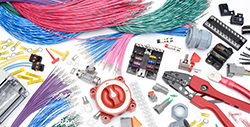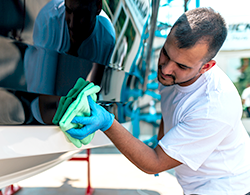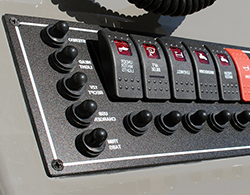Getting in Gear for Boating Season
Posted by Pacer on 1st Mar 2022

Boating season is the time of year when your boat will get the most usage. This means that it needs to be ready for the constant vibration, exposure to elements, and other factors that it will be subject to. Before you put your boat back into the water, you will want to consider a few critical factors about its condition and level of preparedness. You may even need to consider replacing some of your electrical parts.

So, where do you get your electrical parts after you have had your boat for years? You get them here. We offer everything from wire and cable, to switches and tools, to heat shrink and panel blanks. Basically, we are your one-stop-shop where you can find everything you need and more. So now that you know where to go to get the highest quality parts you need, let’s look at the first step in getting your boat ready, conducting basic routine maintenance.
Conducting Basic Maintenance
We have covered this before, but a quick reminder never hurt anyone. When conducting maintenance, you will want to inspect your boat’s fuel system, batteries, cooling system (if your boat has one), belts, oil, and other applicable areas. Make sure to look for signs of wearing, cracking, chipping, or any other form of damage.
![]()
For the fuel system, make sure that there are no leaks, cracked hoses, or damaged connection points. If you find any of those things, replace the damaged part as soon as possible. A fuel leak can do more than just leave you stranded; it can cause a fire. If you notice a leak while out on the water, use high grade electrical tape to secure it until you can properly repair it.
![]()
When looking at the battery, inspect for signs of corrosion or leaking. Also, look at your connection point. When is the last time you changed out those battery cables? With time, battery cable conductors can corrode, or the insulation can become brittle. The best bet is to replace the battery cable assembly or build a new one yourself with the proper battery cable, lugs, and heat shrink.
![]()
The belt is a little trickier as you need to equally inspect what the belt is touching. Look at the pulleys and connection points for signs of corrosion or wear. Also, check the belt itself for signs of cracking or tearing as these are serious concerns. Lastly, do not forget to tighten the belt if needed.
![]()
The oil is a bit of a different story. Changing the oil on your boat is not the same as changing the oil in your car. If you have never changed boat oil, do not do it yourself. Let a professional handle it. If you decide to do it yourself and need a quick refresher, this guide should be helpful.
Give the Boat a Good Once-Over

With maintenance out of the way, we can focus on giving the whole boat a once over. Whereas the maintenance aspect was zoomed in on specific areas, this is more of a macro view. Looking at the whole boat at once gives a new perspective and may bring to light things you would not have noticed. While viewing your boat look at things like the hull, ladders, hatches, fittings, and the like. If your hull has signs of cracking, you need to address that immediately. Make sure that your ladder is snug and that all connection points are solid. If you run into an issue while inspecting your boat, check out this article to help to find a solution. This is the perfect time to wash your boat making sure to only use marine grade cleaning products. The wrong products can have aversive effects. While you’re at it, you can protect your boat motor or its connection points using Scotchkote or an insulating sealer. With maintenance and cleaning out of the way, we can turn our attention to equipment inspection.
Check Your Navigation Equipment

Making sure that your navigation equipment is properly functioning should be your first task. Checking your lights, radio, and GPS are all smart moves that can prevent issues further down the road. Speaking of lights, it’s a good idea to keep a few spare bulbs on board just in case. Now that we have looked at your navigation equipment, let’s inspect the switches and covers that control those devices. If your switch covers look faded or worn, now is the best time to change them. Choose from hundreds of switch cover options and find the ones you’re looking for. We even offer etched switch covers. If you need to replace the switch bodies, we offer those as well as panel blanks. You could literally build a new panel from scratch with our product line. Once you are satisfied with your navigation equipment let us look at safety.
Check Your Safety Equipment

Honestly, safety should be the first thing and the last thing you look at. We cannot stress enough the importance of safety. Make sure to inspect every life vest to ensure that they do not have any rips, tears, or discoloration. We mention discoloration as it can be the first sign that the vest is no longer safe to use. Once you are sure that each vest is still safe to use, make sure that they fit properly. An improperly fitting vest can be more deadly than having no life vest at all. Seriously! Once you have inspected your vests, check your horn as well as your fire extinguisher. These three things have saved countless lives and should not be overlooked. For a more in depth look at safety equipment, check out this article.
Your One-Stop-Shop

Remember Pacer for all your electrical needs. Whether you’re looking for wire, cable, terminals, connectors, battery posts, switch covers, fuses, fuse blocks, meters, tools, I.D. products, wire management materials, tapes, sealants, or panel blanks, you’ll find it with Pacer. Trust the name some of the world’s largest boat builders turn to for their electrical solutions. Click on the link below to be taken to the corresponding page.
- Wire & Cable
- Multi Conductor Cable
- Battery Cable Assemblies
- Terminals & Connectors
- Electrical Parts
